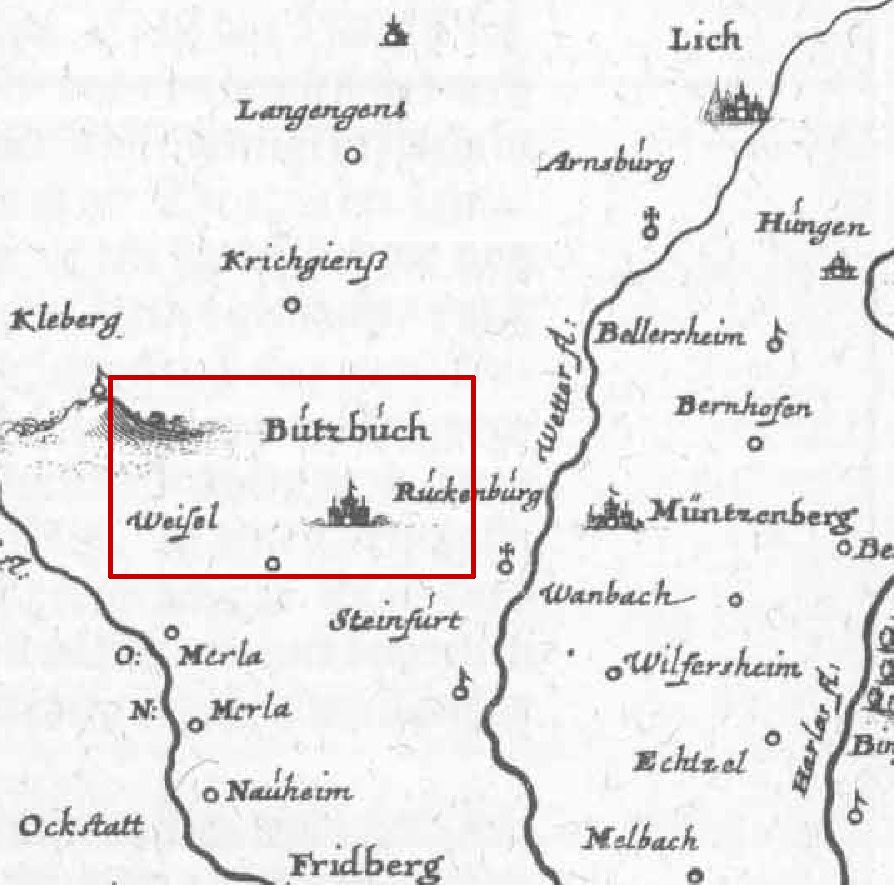Johann Daniel Weisel (1619-1694)
Muschenheim, Hessen
The Wetterau is a fertile undulating tract, watered by the Wetter, a tributary of the Nidda River, in the western German state of Hesse, between the hilly province Oberhessen and the north-western Taunus mountains. The Wetterau region has a long history and is one of the oldest cultural landscapes in Germany. It was always a very fertile region and was populous from as early as the Neolithic Age. The Wetterau was conquered by Ceaser Domotian (81-96 A.D). To protect the area from the Germanic tribes, a number of Roman forts and roads were built in the Wetterau. To mark and fortify the boundaries, a construction called the "Limes" was built. The end of the Wetterau Limes came in the year 259-260 AD, when Rome abandoned all areas to the east of the Rhine.
In the early middle ages, the present day village of Butzbach appeared outside the ruins of a Roman fort and the remains of the largest Roman camp village in the Wetterau.

|
One origin of the surname Weisel is a Wetterau/Hessen place name. The name originates from the village called Weisel (in the middle ages), or Nieder-Weisel (today) located about 2 km south of Butzbach. In the Middle Ages when surnames were being adopted, likely a person of importance or prestige in the village of Weisel, chose Weisel/Weissel as his surname. It's likely this person was a descendant of the Roman occupation, either an officer, soldier, worker, or slave. As of early 2024, only one Weisel descendant from Muschenheim, nearby to Butzbach, has tested with the Weisel FamilyTreeDNA Group Project. His Y-DNA result and his Y-DNA haplogroup is E-V22. E-V22 represents the last major African migration out of NorthAfrica and the Nile Delta into Greece, Albania and the Mediterranean area about 8,000 to 10,000 BCE (Before the Christian Era). |
 Marriage record for Johann Daniel Weisel
Marriage record for Johann Daniel Weisel
(LDS Lich #1197034 March 3, 1639)
 Death record for Johann Daniel, his wife
Adelheit, and oldest son Johann Wolf.
Death record for Johann Daniel, his wife
Adelheit, and oldest son Johann Wolf.
(LDS Muschenheim #1336781-KB02)
Descendants of Johann Daniel Weisel (1619-1694)
Last update: Quite a few years past
Record keeping does not go back far enough to determine when the first Weisels arrived in Muschenheim. The first recorded evidence of Weisels in Muschenheim are Johannes, Nicolaus, Herman, and Caspar Weisel. Johannes was born about 1580-1595. He is named as the father in the marriage records of Johann Daniel (1639-Lich) and Werner (1646- Muschenheim). Nicolaus Weisel, born about 1590, entered Marburg University in 1606 and 1608 and is listed in the Muschenheim 1633 tax rolls. In 1665 there is Elsa Weisel's death record. Elsa was a widow of Casper Weisel and she died aged 56 years. In 1636 Christina Weisel married Hans Wolf Mentz in Lich. Christina was the daughter of Herman Weisel of Muschenheim. Herman would have been born approximately 1580-1594.
There were also Weisels in the Muenzenberg church records during the 1600s. There were births recorded in the parish records up to 1723. In Bettenhausen, the village located east of Muschenheim, Gilbert Weysel is listed as a citizen in 1651 and 1670.
The Muschenheim church books begin in 1644. This is 9 years after a bubonic plague epidemic in this area of Hesse and 4 years before the end of the 30 Years War. Two sons of Johannes are present, Johann Daniel and Werner Weisel. Werner had 3 daughters who lived to adulthood. Johann Daniel had a daughter and 4 sons who married and left descendents in the area. Today there are many descendents of Johann Daniel bearing the Weisel surname living in the Lich, Birklar, Eberstadt, Muschenheim, Gambach, and Muenzenberg area of Germany. Great great great grandchildren of Johann Daniel emigrated to the US in the mid 1800s and settled in midwestern and western states. They too prospered and had many sons.
My immigrant ancestor is Johann Georg Weisel, documented on WikiTree, who immigrated to Wisconsin in 1850 from Gambach, Wetteraukries, Hessen. Johann Georg joined his brother Konrad Weisel who immigrated from Muschenheim, Kreis Lich, Giessen, Hessen to Wisconsin in 1850. They both homesteaded in the "German Settlement" located in Northern Columbia County and Southern Green Lake County.
This page was created Aug. 25, 1999 and last modified January 2024
If you have corrections, additions, or other information you would like to see added to this web resource, please Contact Me
Since 12/4/2020
